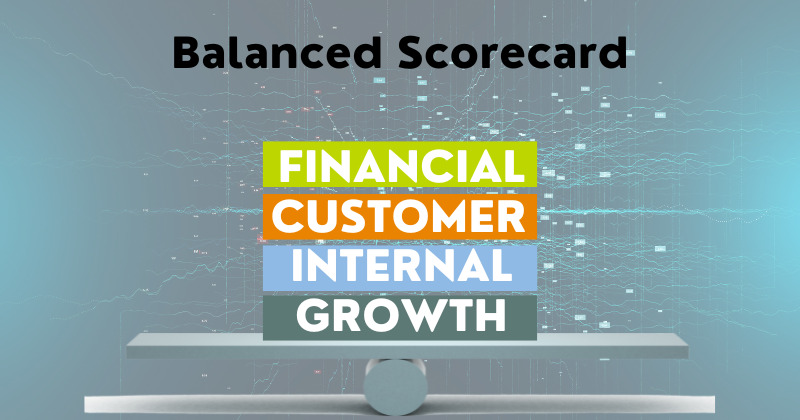Follow the Leaders
Use a Balanced Scorecard to Measure Business Performance
“There were 5 exabytes of information created between the dawn of civilization through 2003, but that much information is now created every two days.”
Eric Schmidt, Executive Chairman at Google
A Game Changed
The future’s history books — which I’m guessing will only exist in some digital format — will undoubtedly chronicle the past 50 years as a nearly incomprehensible explosion in human knowledge.
The period from the late 1970s to now has been referred to by many names: The Computing Age, The Dawn of New Media, The Digital Age. No matter the name, modern society has crowned information as its king and as a result, the new battlefront for modern business is data and analytics.
No matter the industry, the consequence of losing the data war with competitors is incomplete (and/or bad and/or nonexistent) information informing critical decisions by executive leadership. Making matters worse, the new landscape has rendered many traditional organizational measures obsolete. In response, new tools and weapons for this new data war had to be forged.
Finding Balance in the Data Onslaught
In 1992, two esteemed professors at Harvard, Robert Kaplan and David Norton, saw the new paradigm and went to work developing just such a tool. It was called the balanced scorecard.
Time and perspective have shown the now-obvious shortfalls of measuring an organization in strictly financial terms. Even a century ago, the operations and strategies of most large American companies were far too dynamic to accurately assess with the same handful of pecuniary benchmarks.
Fast forward to now and the complexities of the modern age and it’s genuinely silly to think any single measure (or a handful of measures) could give a comprehensive picture of the overall health of an organization. We need balance. We need a more dynamic assessment of performance vs. objectives. We must consider the financial and the non-financial. We can achieve this through the scorecard.
Take Key Performance Indicators Beyond Finance
It’s noteworthy here to mention that entire college courses are devoted to the minutia of building Kaplan and Norton’s balanced scorecard. Lucky for us, it remains a relatively easy concept to explain at a high level. In a nutshell, it’s a simple framework in four easy parts: Financial, Customer, Internal, and Growth. For each, the task is simple: find the key performance indicators.
While there is no shortage of financial measures to use as KPIs, the other three areas might require a deeper dive.
Struggling to measure overall customer satisfaction? Take a look at what percentage of your widgets get returned. Trying to assess internal efficiency? One might look at the length of lead time between product design and going to market. Unsure about your company’s capacity to innovate? The examples are bountiful and the results are almost always transformative. One of my favorite clients of all time used to live by one mantra: a process examined is a process improved.
To this, I might also add that a process, upon examination, usually reveals how poorly company metrics accurately capture the success or failure of specific strategies. I liken it to focusing on a restaurant’s food servers to evaluate the efficiency of the cooks.
Proven Effectiveness
Now, speaking conceptually about the scorecard provides a great overview, but nothing better demonstrates its effectiveness than its real-world assimilation into the world’s biggest company, Apple.
For context, Apple had traditionally focused almost exclusively on its technologies building computers. Executive leadership was product-focused, and their measures of choice were the same contemporary gauges used by most other large global enterprises (ROI, gross margin, market share, etc).
The task of procuring feedback from outside the company had usually fallen on third parties like JD Power. Apple knew the limits of depending on someone else for such critical input and executives had come to realize that then-current measures were not capable of articulating the effectiveness of critical strategies. Leadership’s response was to adopt Kaplan and Norton’s balanced scorecard.
All four elements (Financial, Customer, Internal, and Growth) were considered by Apple executives. Going forward, financial measures would emphasize shareholder value; from the internal process perspective, core competencies; the Growth perspective, employee attitudes. And perhaps the most important change was an emphasis on the customer perspective through market share and customer satisfaction.
Apple no longer outsourced customer feedback. They developed specific surveys that sought to inform their future. From them, the computer builder realized their loyal but disparate customers were looking for similar things; user-friendly interfaces, more powerful software architectures, and better distribution systems — things that define what we now think of when we think about Apple.
Link Measures to Activities in a Dashboard
Finally, once an organization has undertaken the leadership responsibilities and heavy lifting of building its individualized scorecard, it would be short-sighted not to link those results and KPIs to a dynamic, powerful, and highly effective dashboard.
In my experience, dashboards are one of the best tools for first linking measures to activities, then activities to objectives, and finally objectives to performance. ZOHO is my favorite. It’s the best dashboard value out there. (And no, I’m not a paid spokesperson nor do I benefit in any way from this endorsement).
About the Author
Russ Gambrel, a finance & accounting consultant for Fahrenheit Advisors, is a CPA with more than 22 distinguished years of accounting, auditing, and information systems experience. He has spent the last ten years working with a who’s-who list of Virginia-based start-ups and large companies consulting extensively as both a fractional CFO and Controller. Prior to moving to Virginia, Russ tracked countless miles from his start in Silicon Valley to Washington, D.C., leading both small and large companies in their Sarbanes-Oxley compliance efforts. Before joining the private sector, Russ worked and lived in the European theater as a Budget Director with the DOD. Additionally, he is a former University accounting and finance instructor whose Master’s studies in Information Systems focused on relational database design.


I have implemented the Balanced Scorecard at three companies where I’ve served as CEO, CFO, and COO. In every case, I found the BSC to provide insight that just isn’t available through pure financial measurements. One of the most valuable aspects of the BSC is its use as a tool for communication related to the performance of those who drive the numbers. At my current firm, I travel quarterly to all 10 offices to communicate the firm’s performance and the office performance using the BSC. If you get the Client, Operations, and Learning and Growth parts right, strong Financial performance will follow. The key is in choosing the right measurements that drive the right behaviors.